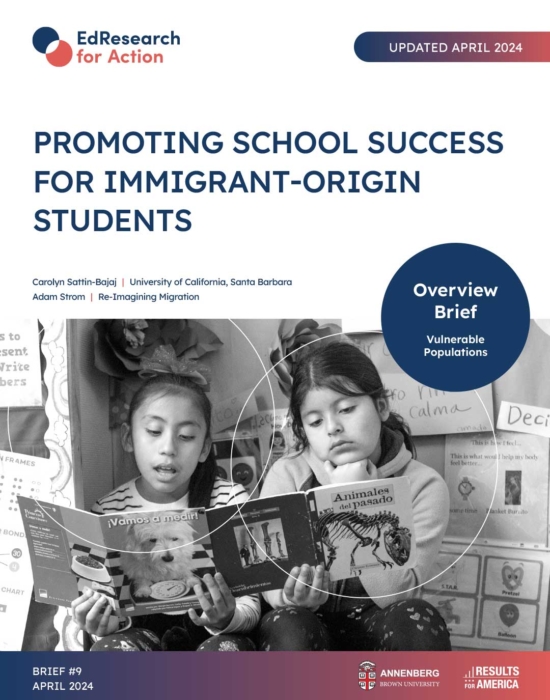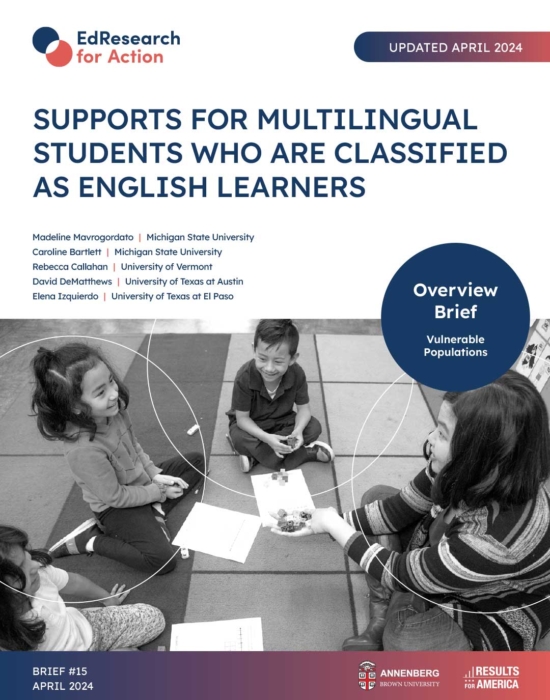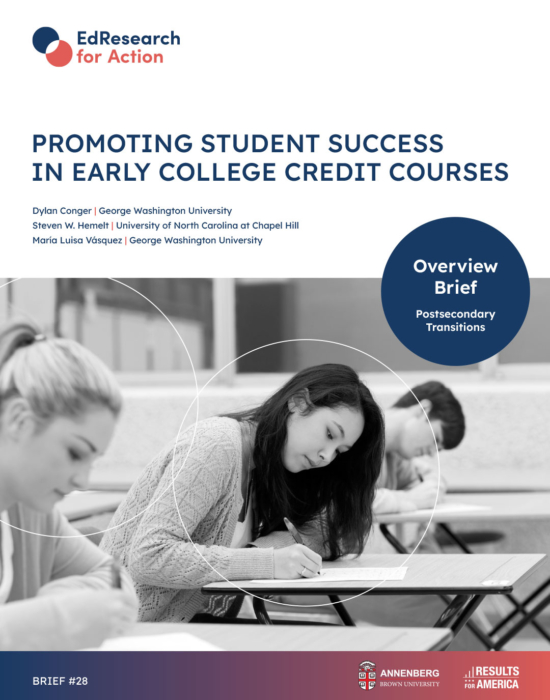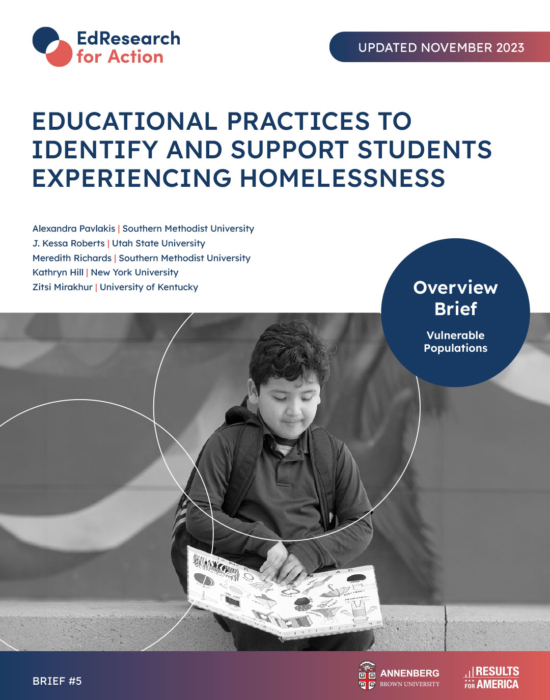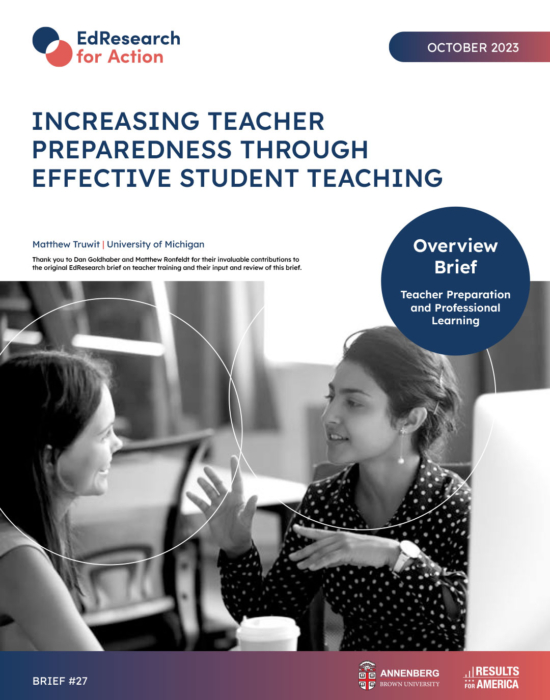Strengthening School Connectedness to Increase Student Success
The EdResearch for Action Overview Series summarizes the research on key topics to provide K-12 education decision makers and advocates with an evidence base to ground discussions about how to best serve students. Authors – leading experts from across the field of education research – are charged with highlighting key findings from research that provide concrete, strategic insight on persistent challenges sourced from district and state leaders.
Robert Balfanz | Johns Hopkins University
Angela Jerabek | BARR Center
Krystal Payne | University of Chicago
Jenny Scala | American Institutes for Research
May 2024 | Brief No. 29
Central Question
What is the evidence on strategies to build a sense of school connectedness and engagement among all students?
Key Insights
Breaking Down the Issue
- Across all grade levels, students who feel more connected to school have higher attendance rates, higher academic outcomes, and higher graduation and post-secondary success rates.
- Positive school connectedness has been consistently linked to various positive health outcomes, including lower levels of substance use, better mental health, and reduced violence.
- A significant number of students, particularly those from marginalized communities and ninth graders, report a lack of supportive adult relationships and meaningful engagement at school
Evidence-based Practices
- Successful efforts to build school connectedness begin with assessment, which enables staff to establish a baseline, identify areas for improvement, and monitor progress.
- Students feel more connected to school when teachers use explicit strategies to show that they care about them, know them as individuals, and are willing to respond to their distinct needs.
- Disciplinary policies directly affect student engagement – and students who see their teachers take action against bullying feel a strong connection to their schools.
- For many students, engagement in school develops through extracurriculars – and schools that offer students opportunities to mentor, tutor, or self-govern see stronger connectedness across the community.
- Embracing cultural diversity in schools through inclusive curricula and family involvement builds a school environment where all members feel valued, respected, and connected.
Practices to Avoid
- School connectedness can’t be mandated or coerced, and creating new organizational structures and responsibilities will not succeed without meaningful engagement from both teachers and students.
- Only recognizing students who achieve in academics can make some students feel like lesser members of the community.
- Addressing students’ disengagement in public tends to make them feel even less connected.
Breaking Down the Issue
What is school connectedness, and why is it important?
In 2003, the U.S. Centers for Disease Control, the Robert Wood Johnson Foundation, and the University of Minnesota convened a meeting of experts from the education and health sectors to synthesize what’s known from the research on a number of overlapping topics such as student engagement, school climate, children’s mental health, peer bonding, and student-teacher relationships. They found that these various strands of research all point to the same overarching conclusion: “Students are more likely to succeed when they feel connected to school.”
Over the two decades since then, researchers have identified four specific factors that contribute to feelings of school connectedness. Students feel connected:
- When they perceive that specific teachers and/or staff know and care about them as individuals
- When they belong to a supportive peer group
- When they are engaged in prosocial school activities, in which they perceive themselves to be supportive of others
- When they feel accepted within the school community for who they are
These sources of connection matter to all students, helping them develop a strong sense of agency, well-being, and engagement in learning. (In effect, connectedness is the inverse of disengagement, which stems from students’ sense that nobody at school notices, cares about, or accepts them and that there’s no real point to the school activities and classroom lessons they have to endure.)
Increasingly, researchers have argued that these four components add up to a single, comprehensive framework that can guide educators in their efforts to improve student outcomes. That is, many experts — ourselves included — recommend that in order to create a setting that promotes student success, school leaders should address all four of these components simultaneously, rather than focusing on just one or two of them.
How does school connectedness relate to academic, personal, and health-related outcomes?
Across all grade levels, students who feel more connected to school have higher attendance rates, higher academic outcomes, and higher graduation and post-secondary success rates.
- Elementary and middle-level students who feel connected to school have higher attendance rates, fewer disciplinary problems, and better academic outcomes. They also go on to have better high school graduation rates and greater success in post-secondary education than their less-connected peers.
- Studies conducted at the high school level have found that efforts to promote students’ social-emotional development, which includes student connectedness, are associated with higher graduation rates and greater rates of college enrolment within two years of graduation. Also, researchers have found that school connectedness among adolescents is strongly associated with positive classroom environments, reasonable (not excessively harsh or punitive) disciplinary policies, small school size, and active student participation in extracurriculars.
Positive school connectedness has been consistently linked to various positive health outcomes, including lower levels of substance use, better mental health, and reduced violence.
- Students who report they have key attributes of school connectedness report lower levels of anxiety and depression. These students were also less likely to report poor mental health and suicidal thoughts during the COVID pandemic, even when they attended school virtually.
- High levels of school connectedness are associated with less reported participation in risky adolescent behaviors, including the use of drugs and alcohol, and with better adult health outcomes.
- Longitudinal studies have found positive associations between school connectedness in adolescence and mental and physical well-being in adulthood.
To what extent do students across the United States feel connected to school?
A significant number of students, particularly those from marginalized communities and ninth graders, report a lack of supportive adult relationships and meaningful engagement at school.
- The California Health Kids Survey found that 63% of 7th graders, 60% of 11th graders, and 55% of 9th graders report having support from a caring adult at school.
- The 2021 Youth Risk Behavior Survey found that less than 40% of high school students reported that they did not feel close to people at their school, a critical part of school connectedness.
- 52% of LGBTQ+ youth reported feeling close to people at school, compared to 65% of their non-LGBTQ+ counterparts.
- During the height of the pandemic, only 35% of students from marginalized communities reported experiencing a key element of school connectedness: an adult at school who knew and cared about them as a person, compared to 50% of all high school students
- 9th graders consistently report the lowest developmental support at school, even though engagement indicators tend to decline across grades.
Evidence-based Practices
What does the research say about effective ways to increase school connectedness?
Successful efforts to build school connectedness begin with assessment, which enables staff to establish a baseline, identify areas for improvement, and monitor progress.
- Each of the four components of school connectedness can be measured systematically via school climate surveys, student surveys, interviews, focus groups (including students and/or faculty and staff), and the analysis of school records (such as disciplinary referrals, absences, and rates of participation in school activities and extracurriculars).
- Researchers at the Harvard Graduate School of Education have created a mapping tool that teachers can use to identify students who appear to have few positive relationships with teachers, staff, and/or peers.
Students feel more connected to school when teachers use explicit strategies to show that they care about them, know them as individuals, and are willing to respond to their distinct needs.
- A meta-analysis of individual and social level factors that influence school belonging found that teacher support is the strongest predictor of student belonging.
- Simple practices, such as greeting students warmly at the classroom door and identifying points of similarity among students and teachers (by, for example, asking them to fill out a survey on interests, and using this information to bring together students and adults with common interests during advisory or club periods) can lay the foundations for positive student-teacher relationships. Staff at High Tech High School have developed evidence-based tools to facilitate empathetic discussions between teachers and students
- The Search Institute has identified five key, research-based principles with specific, actionable steps to foster meaningful and impactful relationships with students: expressing care, challenging growth, providing support, sharing power, and expanding possibilities.
- Communicating and modeling the belief that all students are capable of personal and academic success and should be held to high expectations is associated with high levels of school belonging.
- Teacher professional learning programs that focus on fostering stronger relationships between teachers and students have demonstrated significant benefits, including increased student learning and decreased disciplinary issues. For example, brief interventions aimed at enhancing empathy among teachers have successfully reduced disciplinary referrals, particularly for at-risk students, while fostering a more supportive and respectful classroom environment.
- Less formal settings outside of school typically provide greater opportunities to develop the kind of trust-based relationships that are beneficial for social and emotional learning and connectedness. Leading extracurricular activities and clubs allows teachers to mentor and coach students in less formal, out-of-classroom settings.
Disciplinary policies directly affect student engagement – and students who see their teachers take action against bullying feel a strong connection to their schools.
- Students feel a stronger sense of connection to their school when they believe that their teachers are prepared to intervene in bullying situations. This underscores the crucial role of teachers in creating a positive school environment where students feel supported and valued by school staff.
- Schools with less severe punitive discipline policies tend to have higher levels of school connectedness. Restorative justice is increasingly being recognized as a promising alternative to traditional discipline and focuses on repairing harm when students misbehave through open discussions. In Oakland Unified School District, restorative justice approaches have successfully resolved conflicts and harms in over 76% of cases, and improved students’ abilities to understand peers, manage emotions, and maintain positive relationships. These approaches have also contributed to an improved school climate, with nearly 70% of staff noting its positive impact on their schools.
For many students, engagement in school develops through extracurriculars – and schools that offer students opportunities to mentor, tutor, or self-govern see stronger connectedness across the community.
- Involving students in school councils and other organizational structures has been found to enhance school connectedness. Teachers and staff can encourage students to participate in designing school activities that provide opportunities for community-building and welcoming newcomers to the community.
- School service work (such as acting as a peer mentor, tutor, or school ambassador) has also been shown to create more opportunities for students to experience school activities with prosocial components.
- When teachers proactively address social dynamics and foster positive interactions in the classroom, students report feeling more connected to their peers.
- Research indicates that students who have friends from diverse backgrounds tend to be more engaged and have a greater sense of belonging. These friendships expose students to different perspectives, traditions, and experiences, promoting empathy and open-mindedness.
- Extracurriculars are often where students find meaning in school participation and opportunities to help others. Surveying students allows school leaders to gauge their interest in existing activities and better identify ways to increase access and participation, such as highlighting a demand for new clubs or eliminating activity fees.
Embracing cultural diversity in schools through inclusive curricula and family involvement builds a school environment where all members feel valued, respected, and connected.
- When schools actively celebrate and incorporate diverse cultural perspectives in the curriculum and school activities, students are more likely to feel valued, respected, and connected to their learning environment.
- School events and activities that actively involve families from diverse backgrounds enhance cultural understanding among teachers, students, and families, reduce stereotypes, and foster a more inclusive and respectful school environment. valued.
- Teachers can encourage students to pursue their own academic “passion projects” by helping them understand the larger significance and bigger purposes of what they’re studying, as well as allowing them to choose their own research topics, design their own projects, and teach their classmates about what they’ve learned.
- A recent review of research points to four ways in which educators can help students feel that they are valued members of the school community: 1) They can help students build social skills related to belonging, including skills such as active listening and asking respectful questions about peers’ cultural backgrounds; 2) they can provide opportunities for belonging, such as teams, events, and discussion groups; 3) they can encourage students’ motivation to belong by, for example, validating their desire to dress a certain way or create a club for peers who share their identity, and 4) they can challenge negative perceptions about who belongs, such as by teaching students that embracing one cultural identity doesn’t mean that they have to reject another one.
Practices to Avoid
School connectedness can’t be mandated or coerced, and creating new organizational structures and responsibilities will not succeed without meaningful engagement from both teachers and students.
- Attempts to mandate or incentivize behaviors that support school connectedness can backfire if the relationships do not seem authentic; students will not see support as genuine if they perceive it as obligatory or rewarded.
- School leaders may attempt to enhance school connectedness by establishing structures that provide opportunities for teachers and students to forge stronger relationships, such as mandating teacher mentorship during advisory periods. However, these efforts will fail if teachers view them merely as formal duties; successful school connectedness requires genuine engagement in meaningful activities and experiences by both teachers and students.
Only recognizing students who achieve in academics can make some students feel like lesser members of the community.
- Belonging comes before achievement. There is nothing wrong with celebrating students who make the honor roll, participate in student government, act in school plays, or stand out on the ball field. But in providing such recognition, educators can unwittingly send the message that other students are lesser members of the school community. Every student needs to feel welcomed, wanted, and valued, even if they haven’t achieved in formally recognized ways.
Addressing students’ disengagement in public tends to make them feel even less connected.
- In their efforts to connect with disengaged students, educators can unwittingly make them feel even less connected to the school. For example, a teacher might pull a student out of the classroom to ask why they’ve been absent for several days; but if the student suspects that their peers can hear the conversation, they may feel exposed and humiliated, rather than appreciating the teacher’s concern. Or a teacher might welcome the student with a sarcastic or joking comment like, “Ah, you’re back. To what do we owe our good fortune today?” Such discussions are better held in private.


